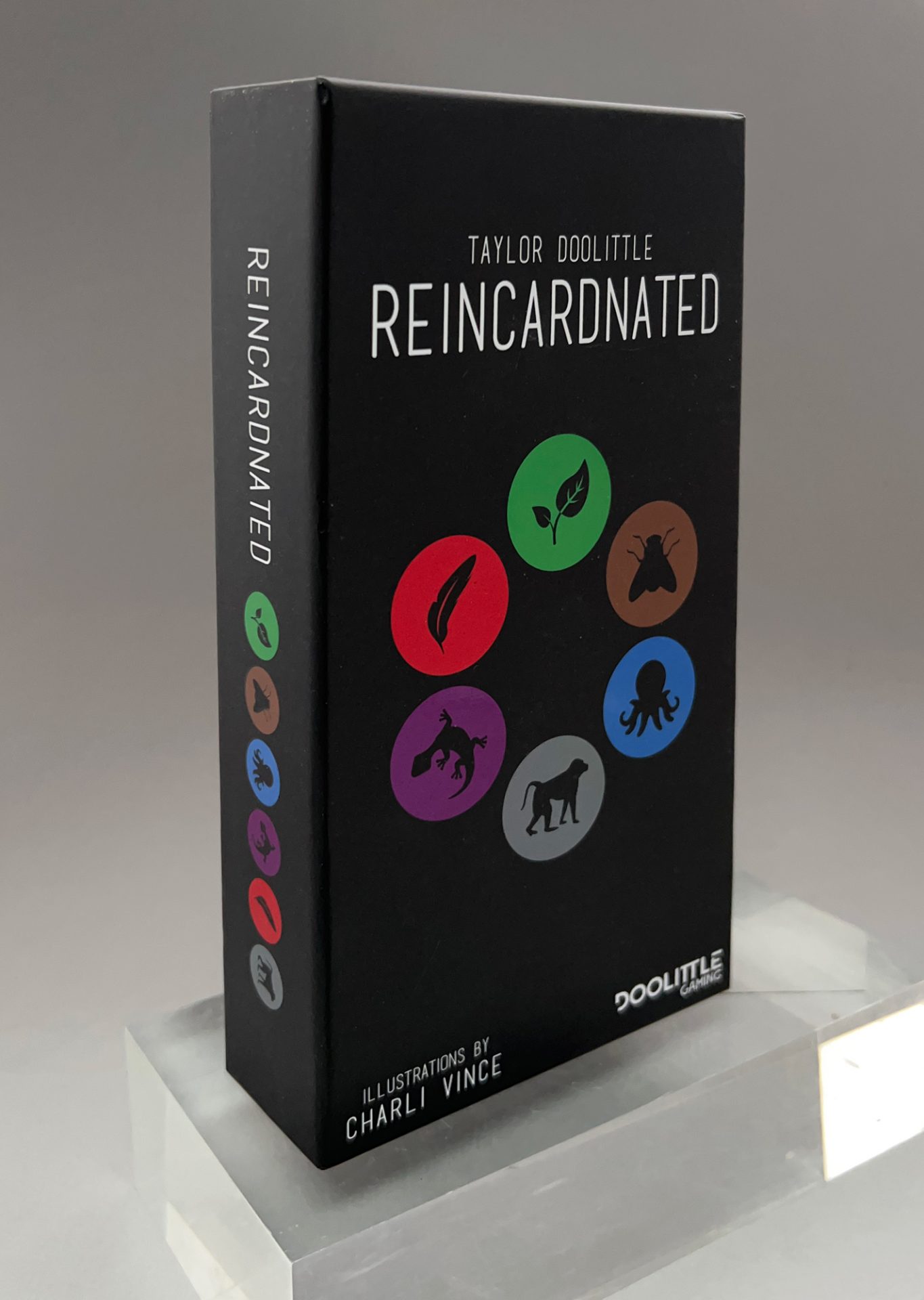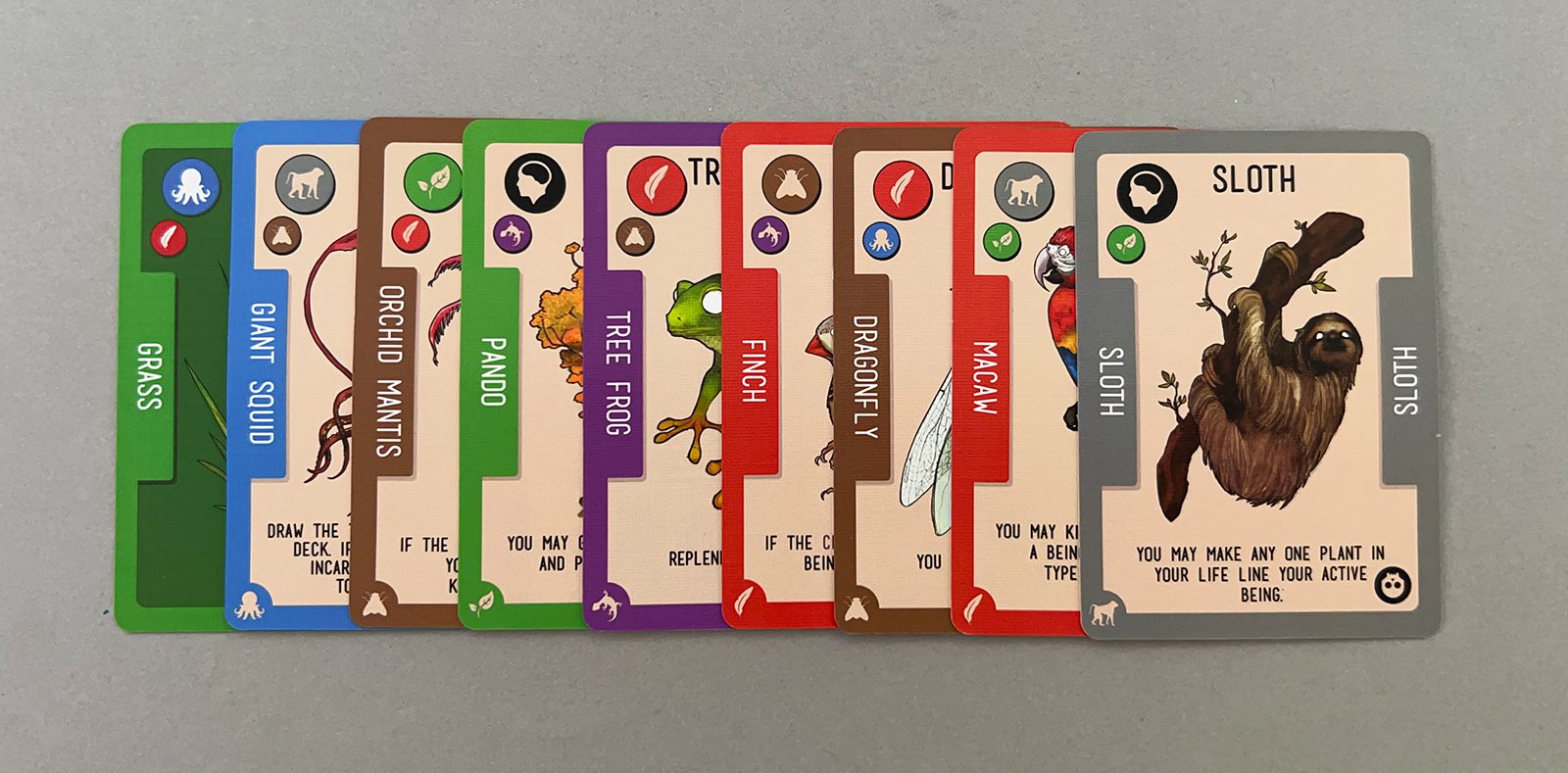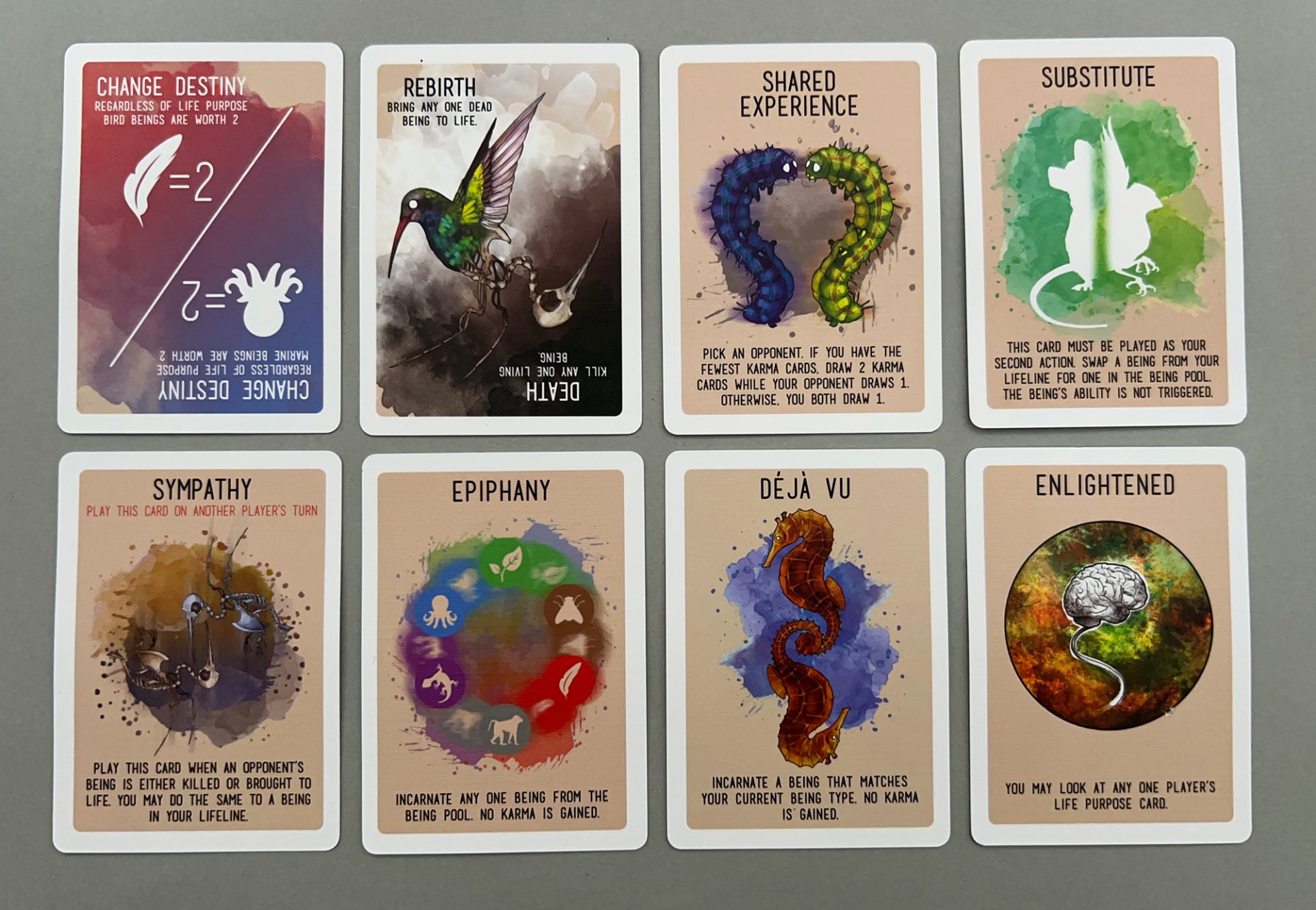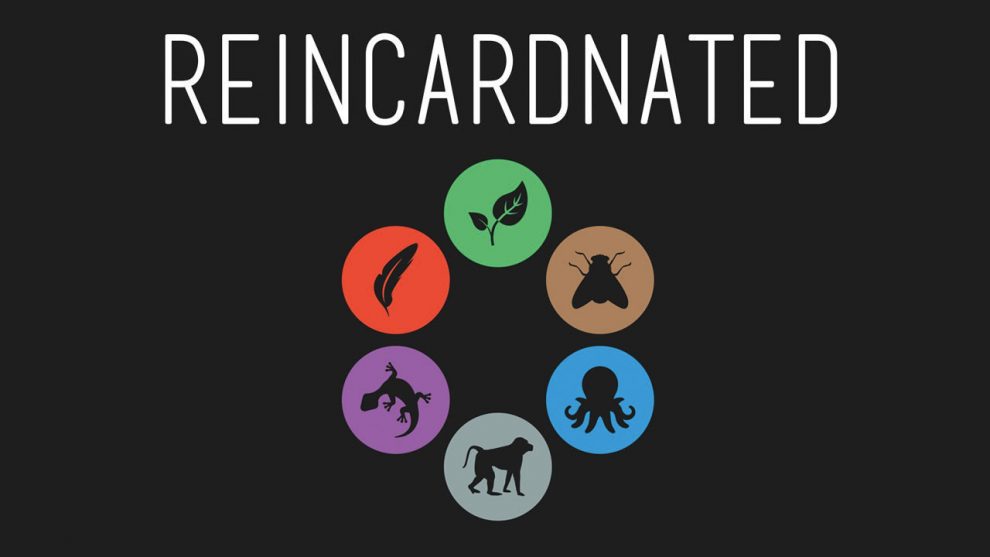Disclosure: Meeple Mountain received a free copy of this product in exchange for an honest, unbiased review. This review is not intended to be an endorsement.
“Reincarnation’s a blast
If you know what you were in the past
And if you don’t mind livin’ in
Fear and desperation. Reincarnation.”
—Reincarnation by Fat City (Bill & Taffy Danoff, 1969)
Reincarnation is the philosophical or religious belief that, after death, the soul leaves one entity and is reborn, or transmigrates, into a new and/or different physical form. As a concept, the idea of leaving one body for another goes back to the ancient Greeks and is central to many Indian religions.
Jergensmeyer and Roof’s Encyclopedia of Global Religions (Sage Publications, 2011) describes this concept as a “cycle of aimless drifting, wandering or mundane existence,” a phrase that brings us nicely to today’s game: Reincardnated.
In Reincardnated, players are trying to extend their Life Lines by reincar(d)nating to and from those creatures that, according to their individual Life Purpose, will benefit them the most.
Forget the Buddhist concept of Nirvana. We’re talking about scoring the most points by fulfilling your Life Purpose better than your opponents.
After all, philosophy and religious practices aside, Reincardnated ain’t no co-op game.

Setup
Separate the cards into five piles, each based on the design on the backs of the cards. These are: Starter Beings (the only cards with green backs), Beings (six different animal icons), Life Purposes (six brains), Karma, (two skeletal birds), and the lone Human (double sided black with Human Form at the top).

Shuffle them well, then deal each player one Starter Being card and one Life Purpose card. Turn your Starter Being card face up—this becomes the start of your Lifeline. Your Life Purpose card is fittingly kept face down and hidden at the start of the game.
Deal each player two Karma cards. These will form the player’s initial hand of Karma cards.
Turn eight Being cards face up in easy reach of all players to create the Being Pool. Place the remaining Being cards to the side, along with the remaining Karma cards and the lone Human Form card.

Now you’re ready to play.
How to Play
On a turn, players may take up to two actions. The first action may only be used to play a Karma card. Your second action is to either play a second Karma card or to Reincarnate a Being from the Being Pool.
Karma cards allow you to change scoring conditions, alter your reincarnation options, steal or kill cards belonging to an opponent (or yourself), change your current being, and many other rules-bending options. More on these later.
To reincarnate, you take a look at your Current Being, that is, the Being card farthest to the right in your row of Beings that is living.
Roughly speaking, there are six Being types: Plant, Insect, Bird, Reptile, Sea creature, and Mammal. Each Being card shows a large drawing of a specific type of Being, with its name at the top and along the left and right edges of the card. The card is also framed with a (non-colorblind friendly) color specific to that Being’s type. An icon for that specific Being is shown in the lower left corner.
In the upper left corner of Being cards are two other Being types, one at the top in a larger circle, and one in a smaller circle, below. These are the two types of Beings your current Being can reincarnate to—respectively, your Being’s Preferred Incarnation and Lower Incarnation. Your third Incarnation option would be to do a Lateral Incarnation, by reincarnating into a being of a similar type.
Take a look at the Being Pool and see if there are any of your Preferred, Lower, or Lateral Incarnation types. Choose the Being you wish to reincarnate to and place it on top of, and to the right of your Current Being to continue your Lifeline. This new Being becomes your new Current Being.

For transmigrating into a Preferred Incarnation, you are rewarded with two Karma cards from the top of the deck into your hand (with a hand limit of seven). Manifesting into a Lower Incarnation only gains you a single Karma card. Lateral Incarnations gain you no Karma cards.

Karma cards allow you to change the rules of the game. Sometimes they change your game, sometimes they change everyone’s game.
Now it’s time to put into effect the text at the bottom of your new Current Being’s card. Read it aloud as it may affect not only your Lifeline but those of your opponents.
Once all effects are settled, play then moves on to the next player.
We Each Have a Different Life Purpose

Remember that Life Purpose card you were dealt at the beginning of the game that’s been face down this entire time? That ominous name is well deserved.
At the end of the game, you’ll score points based on the types of creatures listed on that card, along with two special scoring criteria listed at the bottom of the card. The catch is, however, that also as in real life, you have no idea what your Life Purpose/scoring conditions might be until you reach a certain level of…enlightenment?
Or, in this case, at least, you draw the right card.
There are two ways of discovering/looking at your Life Purpose: you can (a) Incarnate into a creature whose card text allows you to look at a player’s Life Purpose or (b) play an Enlightened Karma card.
And just as each reincarnation requires its own level of spiritual enlightenment to gain a glimpse of its Life Purpose, so goes your Reincardnated’s Life Purpose. After looking at the card, you’ll need to place it face down on the table again. It will take another specific incarnation of another Enlightened card to allow you to look at it again.
Play continues, with players playing Karma cards and reincarnating their Current Beings until someone reincarnates into the Human Form. They place that card to the side of their Life Line and any remaining players get to finish their turns for the round.
Life Purpose cards are then turned over, and points are tallied. The player with the most points wins.
Components
The 175 cards that make up the core of Reincardnated are, unfortunately, a bit lacking. When I asked designer Taylor Doolittle about the cards in an email, he said, “the invoice from AdMagic for the cards lists them as: “350gsm white core, linen finish with PP lamination”.”
While they are a linen finish, they remind me a lot of the playing cards I made, printed on linen paper and stuck together with spray adhesive. They’re stiff, lacking the slick surface that makes them easily shuffled, dealt, or fanned in your hand.
Doolittle did add, “any hopeful reprints/expansions will most likely see a change (in card stock).”
For a game that is, essentially, just several decks of cards, the box is slightly oversized, but not overly so. I get that game publishers are trying to make smaller games appear more substantial by packaging them in larger-than-necessary boxes. (I am, as always, sadly looking at you, Splendor.) Reincardnated’s box is a compromise in size that I can live with.
Thoughts
Along with the cardstock, the cards themselves took a bit of getting used to. Seeing the cards in the Being Pool that your Current Being was able to reincarnate into, based on the Preferred and Lower Incarnations took some getting used to. I’m not sure what the card designer could have done to help with this, but it took us a while to get used to the iconography.
And while I get the idea of your Life Purpose being an initial mystery, the idea of having to remember it,or requiring a second (or third) card to look at it again, for me, became annoying. We House Ruled the idea of once you’ve played a card that allows you to look at your Life Purpose, you can check it again whenever necessary. A small rule, but one that made for a more relaxed game.
I liked the meandering wander through life forms that Reincardnated allowed/forced. At least for a while. The rules state you cannot reincarnate into Human Form until there you have at least six cards in your Life Line (not including their Starting Life Form). Six incarnations is not going to be enough to assure you a win—but without some sort of cap on how many reincarnations the game did feel like it started to drag in many of our playthroughs.
That being said, Reincardnated is an interesting take on card games. With the initial (and continually re-) hidden scoring element and the varying card abilities, there are always any number of interesting choices to be made on your turn. Choosing a card from the Life Pool to Reincarnate to was often a balance between our Life Purpose, the other available cards in the Life Pool to reincarnate into later, and the abilities listed on those cards. Karma cards kept the game spirited with their thematic rule bending abilities.
Just as I admire designer Taylor Doolittle’s imagination in coming up with a game as different and unique as Reincardnated, I’m equally enamored by Charli Vince’s artwork. Not only are the individual Being cards each unique characters, but the artwork used in the more concept-oriented Karma cards are framed-and-hang-on-the-wall worthy.
While I’m not sure how often I’ll bring Reincardnated to the table, it’s going to remain in my collection. I admire what Doolittle was trying to do and I’m very much looking forward to what he and Vince might come up with next.












Add Comment